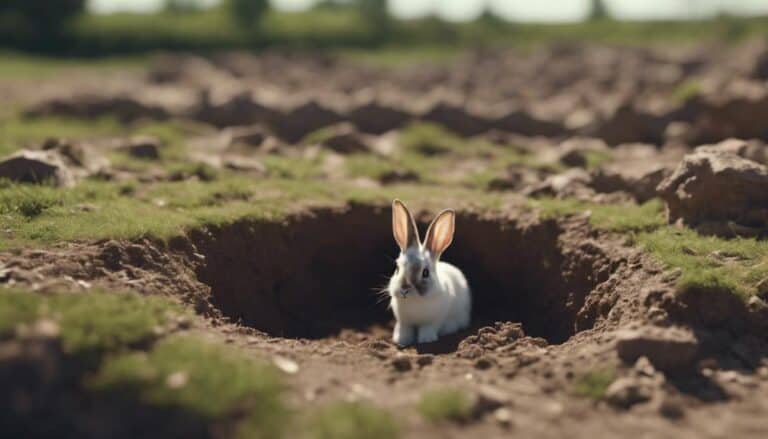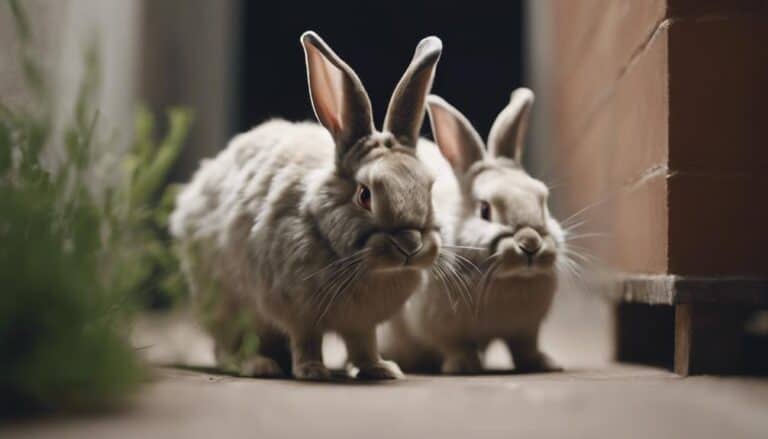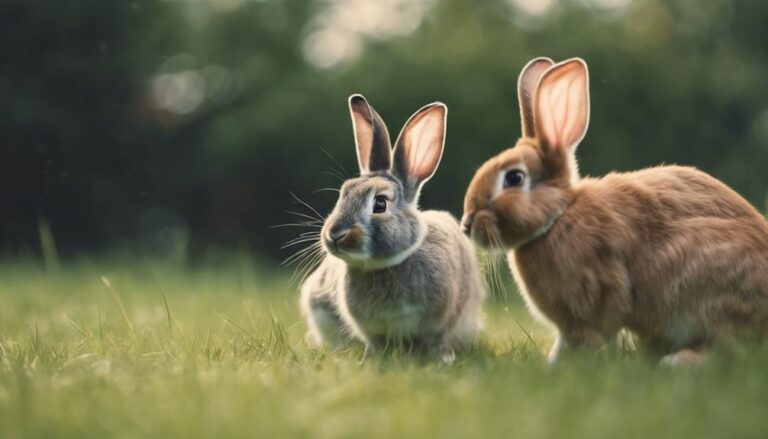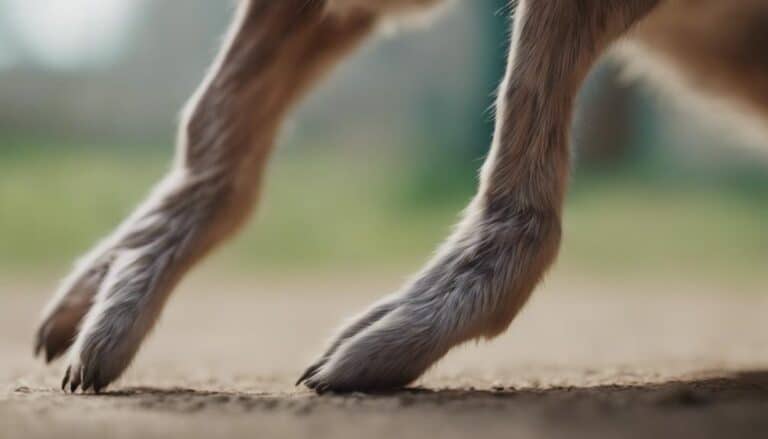Ever wondered why wild rabbits look so different from the ones we keep as pets? It's not just down to chance or genetic differences. The real reason is a lot more complex, involving evolution, adaptation, and the way humans have interfered with these animals.
Wild rabbits have had to adapt to their environment in order to survive. This means they’ve developed certain physical features that help them thrive in the wild, like strong legs for running away from predators, keen senses to detect danger, and thick fur to keep warm in cold weather. Additionally, wild rabbits have also shown remarkable adaptability in their interactions with humans. Some researchers have observed changes in wild rabbit behavior with humans, as they learn to navigate urban environments and exploit new food sources. This ability to coexist with human populations highlights their resilience and intelligence in adapting to both natural and man-made challenges.
These traits have been passed down from generation to generation, making them well-suited to their natural habitats.
Domestic rabbits, on the other hand, have been bred by humans for specific characteristics. We've selected them for things like docility, smaller size, and a range of coat colors and patterns.
This selective breeding has led to some pretty big differences between domestic and wild rabbits.
So, it's not surprising that wild and domestic rabbits look distinct. They've been shaped by different forces – natural selection in the wild, and human intervention in the case of domestic rabbits.
Contents
- 1 Key Takeaways
- 2 Evolutionary Adaptations in Wild Rabbits
- 3 Selective Breeding in Domestic Rabbits
- 4 Fur Color and Pattern Differences
- 5 Size Disparity Between Wild and Domestic
- 6 Ear Shapes and Sizes
- 7 Behavioral Variances in Rabbits
- 8 Environmental Influences on Appearance
- 9 Impact of Human Interaction
- 10 Conclusion
Key Takeaways
So, have you ever wondered why typical wild rabbits look so different from domestic rabbits? It's because they've evolved in different ways.
Wild rabbits have developed natural adaptations to help them survive in their environment. For instance, their speckled fur acts as camouflage, allowing them to blend in with their surroundings. This helps them avoid predators and stay safe.
In contrast, domestic rabbits have been bred by humans for specific traits. This selective breeding has led to a diverse range of characteristics, such as different coat colors, patterns, and body shapes. It's all about what humans find appealing or useful.
Another difference is in their ear shape and size. Wild rabbits have longer ears that help them detect predators from a distance. Domestic rabbits, on the other hand, come in a variety of ear shapes and sizes, depending on their breed.
The main reason for these differences is the way they've been shaped by their environments. Wild rabbits are molded by natural selection, where only the strongest and most adaptable survive. Domestic rabbits, however, are influenced by human preferences and needs.
In the end, it's the environment that determines the appearance of wild rabbits, while selective breeding determines the looks of domestic rabbits.
Evolutionary Adaptations in Wild Rabbits

Wild rabbits have developed some pretty cool physical features to help them survive in the wild. Take the Eastern cottontail, for example. They've speckled brown fur that helps them blend in with their surroundings, making it harder for predators to spot them. This fur is also super fluffy and uniform across their body, which keeps them warm and protected in harsh weather conditions.
But that's not all – wild rabbits also have longer ears compared to their domestic cousins. These ears aren't just for show; they've evolved to help rabbits detect potential threats and predators. It's like having a built-in warning system!
These special features – like the coat color, fluffy fur, and long ears – are a result of natural selection. In other words, rabbits that had these traits were more likely to survive and pass them down to their babies. Domestic rabbits, on the other hand, have been bred for specific traits, so their physical characteristics are a bit different. But for wild rabbits, these adaptations are crucial for their survival and success in their natural habitats.
Selective Breeding in Domestic Rabbits
If you take a look at domestic rabbits, you'll notice a huge range of physical differences.
This is because humans have been selectively breeding them to get specific traits.
As a result, we've ended up with domestic rabbits coming in a variety of colors, sizes, fur types, and ear shapes.
Think about it – humans have played a significant role in shaping what domestic rabbits look like today.
By intentionally breeding for certain characteristics, we've created the diverse range of breeds we see now.
It's pretty amazing when you consider how much humans have influenced the development of these animals.
Domestic Rabbit Diversity
Domestic rabbits are incredibly diverse, thanks to selective breeding. This process has led to a staggering array of physical characteristics and traits across the 305 recognized breeds worldwide.
When you look at the breeds recognized by the American Rabbit Breeders Association Inc., you'll see 49 standard breeds that showcase a wide range of sizes, colors, and features. Some breeds, like angoras and lionheads, have unique fur textures, lengths, and colors that are quite different from what you'd see in wild rabbits.
Domestic rabbits come in a variety of solid colors, including black, white, grey, brown, orange, and red. This is a big difference from the speckled or peppered brownish-red coloration that helps wild rabbits blend in with their surroundings. Breeders have also experimented with ear shapes and sizes, creating variations like lop-eared rabbits that are quite distinct from the shorter, more rounded ears of their wild counterparts.
The amazing diversity of domestic rabbits is a testament to the impressive range of physical traits that have been developed through selective breeding.
Human Influence on Rabbits
Humans have had a huge impact on domestic rabbits through controlled breeding. This process, called selective breeding, has changed the physical traits and characteristics of domestic rabbits in big ways. Essentially, humans choose which rabbits they want to breed based on certain desirable features, and over time, this leads to changes in what domestic rabbits look like.
For example, domestic rabbits now come in a wide range of colors, sizes, and ear lengths, which are different from their wild ancestors.
Even their behavior has been altered through breeding. But these changes aren't just superficial – they can also affect how well rabbits adapt to their environments. Wild rabbits have developed certain traits to survive in their natural habitats, but domestic rabbits might lack these adaptations because of how they've been bred.
Understanding how humans have influenced domestic rabbits is important for appreciating these unique animals.
Fur Color and Pattern Differences
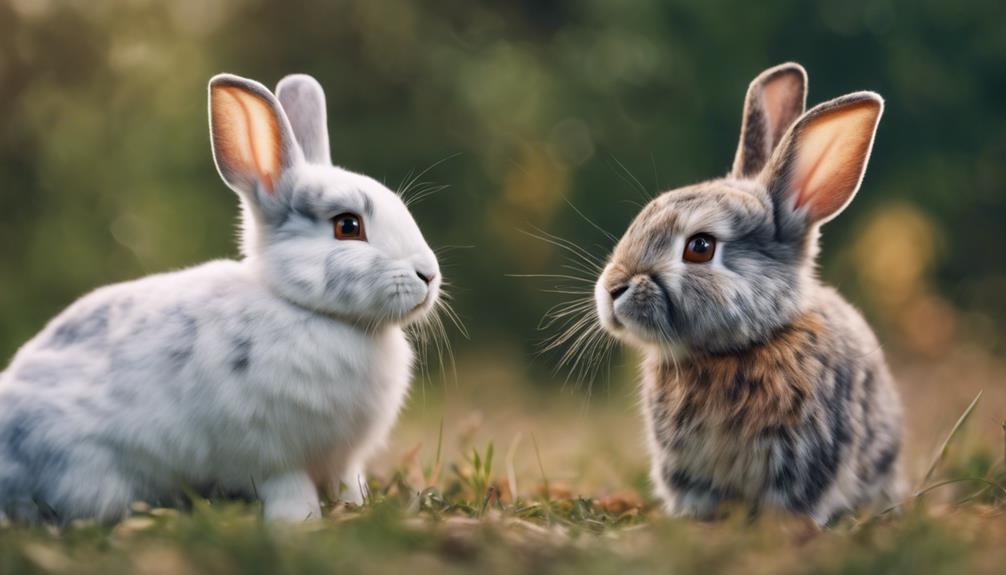
Wild rabbits have a special kind of fur coloration and pattern that helps them survive in their natural environment. Their fur has small specks of brownish-red color, which gives them a peppered look. This speckled brown fur is super helpful because it lets them blend in with their surroundings, keeping them safe from predators.
In contrast, domestic rabbits come in a wide range of coat colors and patterns. This is because humans have bred them over many generations to have these different characteristics.
For example, the wild cottontail, a common type of wild rabbit, always has this speckled brown fur all over its body. This natural coloration is really important for its survival in the wild.
On the other hand, domestic rabbits might've longer, more decorative fur because of the way humans have bred them. The big difference in fur color and pattern between domestic and wild rabbits shows how the environment and humans have influenced how these animals look.
Size Disparity Between Wild and Domestic
The size difference between wild and domestic rabbits is pretty significant.
It's mainly because of selective breeding, which has led to big variations in body size and features. For example, wild rabbits like the Eastern cottontail usually grow to about 15-18 inches long and weigh around 2-3 pounds.
Domestic rabbits, on the other hand, come in all shapes and sizes – some breeds can weigh up to 22 pounds and reach about 4 feet long!
One major difference between wild and domestic rabbits is their body shape.
Wild rabbits tend to have longer bodies, which helps them survive in the wild. This elongated shape makes them more agile and faster, so they can evade predators more easily.
Domestic rabbits, on the other hand, often have more compact bodies. This is because they've evolved in captivity, not in the natural environment.
This size and body proportion difference between wild and domestic rabbits really shows how selective breeding has changed the physical characteristics of these animals.
Ear Shapes and Sizes
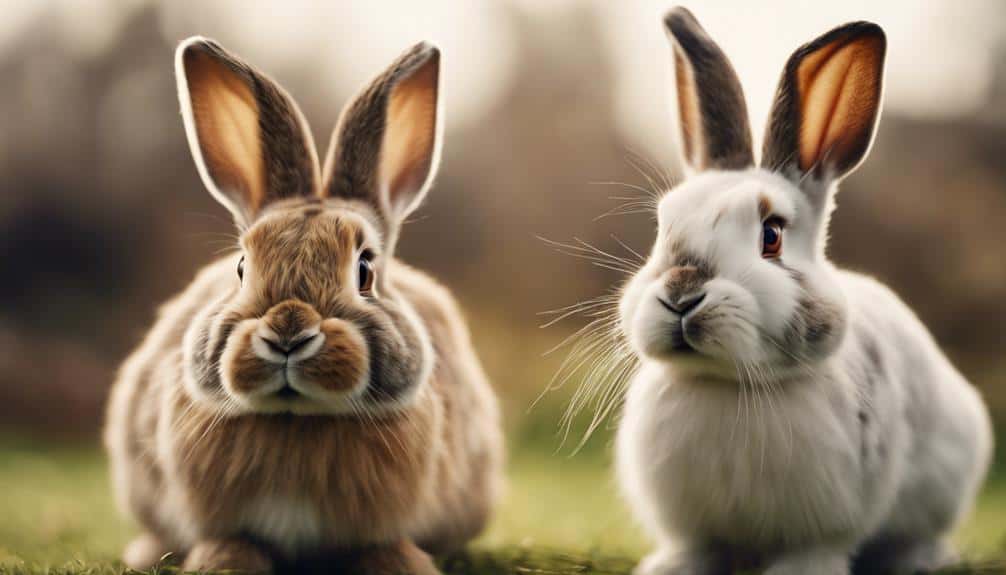
Wild rabbits have bigger ears compared to domestic rabbits, and that's because of where they live and what they need to survive. Their large ears help them stay alert to potential threats and changes in their environment.
Domestic rabbits, on the other hand, have had their ear features changed through selective breeding for various purposes. As a result, you see a wide range of ear shapes and sizes in domestic rabbits.
Looking at the ear adaptations of wild rabbits can give us a better understanding of how well they can hear and how they fit into their ecosystem.
Wild Rabbit Ear Anatomy
When you're out in the wild, you'll notice that wild rabbits have ears that are quite different from those of domestic rabbits. Take the cottontail, for example. Their ears are shorter and more rounded, which is super helpful for their survival.
These ears are usually around 2-3 inches long, which helps them blend in with their surroundings. They're also really good at reducing wind resistance and noise, so wild rabbits can move quietly and stay alert to what's going on around them. Plus, their ears are super mobile, which helps them pinpoint where sounds are coming from – really useful for detecting potential threats.
Domestic rabbits, on the other hand, often have longer, floppier ears that aren't as well-suited to life in the wild. This difference in ear shape is because of selective breeding for certain traits, rather than adapting to their environment. The fact that wild rabbits have shorter, more rounded ears is a great example of how they've evolved to survive in the natural world, giving them the tools they need to thrive.
Domestic Rabbit Ear Features
Domestic rabbits have ears that come in all shapes and sizes, which sets them apart from their wild cousins.
Unlike wild rabbits, which have shorter, rounder ears, domestic rabbits can have ears that are really diverse.
One cool feature of domestic rabbits is that some breeds have 'lop' ears, which hang down instead of standing up straight like wild rabbits do.
Some breeds, like the Lionhead, even have super-long or fancy fur on their ears, which adds to their unique look.
The shape and size of a rabbit's ears can be a big clue in telling domestic and wild rabbits apart.
If you compare domestic and wild rabbits, you'll notice some key differences in their ears.
Domestic rabbits can have all sorts of ear shapes, including lop ears, while wild rabbits have shorter, rounder ears.
Domestic rabbits also tend to have ears that come in all sizes, while wild rabbits usually have smaller ears.
When it comes to breed variations, some domestic rabbits, like the Lionhead, have really fancy fur on their ears, which isn't something you see in wild rabbits.
Evolutionary Ear Adaptations
Ear shapes and sizes in rabbits have evolved over time to serve specific functions and adapt to various environmental conditions. This evolutionary process has led to distinct differences in ear adaptations between wild and domestic rabbits.
In the wild, a rabbit's ears play a crucial role in its survival and reproduction. One key advantage of their ear shape is the increased surface area. Wild rabbits typically have larger ears compared to domestic rabbits, which aids in detecting predators and prey more effectively.
This ability to hear faint sounds allows them to stay alert and avoid potential dangers in their natural habitats. Another important function of a wild rabbit's ears is thermoregulation. The long ears serve as heat dissipaters, helping them regulate their body temperature in hot environments.
By directing blood flow to the ears, wild rabbits can cool down efficiently, ensuring their physiological well-being. Finally, the size and positioning of wild rabbit ears also facilitate non-verbal communication within their social groups.
Ears can be moved to convey emotions, intentions, and warnings, enhancing the survival chances of the group as a whole.
Behavioral Variances in Rabbits
Wild rabbits are quite different from domestic rabbits when it comes to their behavior. For one, they're way more skittish and prone to running away compared to domestic rabbits, which are generally more social and comfortable around humans. This skittishness is actually an adaptation that helps them survive in the wild, where they've to deal with a lot of predators.
In terms of their activity patterns, wild rabbits tend to be more nocturnal, meaning they're most active at night. Domestic rabbits, on the other hand, can be active during the day because they're living in controlled environments.
Wild rabbits are also way more adapted to extreme weather conditions and don't need humans to provide them with shelter and protection like domestic rabbits do.
When it comes to their habitat preferences, wild rabbits and domestic rabbits are like night and day. Wild rabbits live in natural environments like forests, grasslands, and wetlands, while domestic rabbits are usually found in cages, pens, or houses provided by humans.
Environmental Influences on Appearance
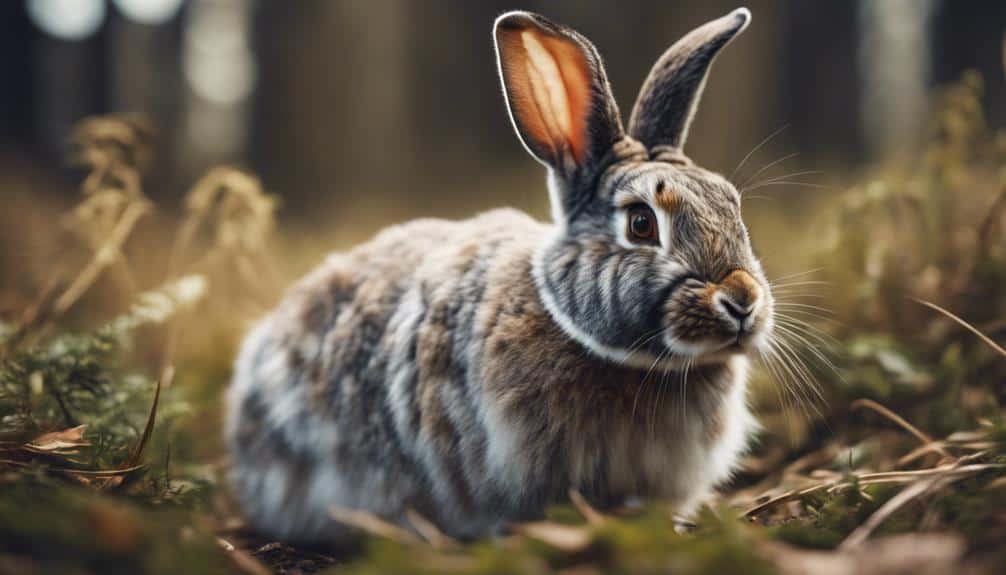
The environmental conditions in which rabbits live play a significant role in shaping their physical appearance.
For instance, wild rabbits have evolved to blend in with their surroundings, sporting a speckled brown coloration that helps them avoid predators. This adaptation is vital for their survival in the wild.
In contrast, domestic rabbits showcase a wide range of solid colors, which is a result of selective breeding practices that prioritize aesthetic appeal over camouflage.
This difference in appearance is largely due to human intervention, which has led to a divergence from the natural speckled appearance of their wild counterparts.
The environmental pressures faced by wild rabbits have influenced the evolution of their physical characteristics, such as fur color and texture, to enhance their survival in their natural habitats.
For example, the speckled brown fur of wild rabbits serves as a natural form of camouflage, helping them evade predators and thrive in the wild.
Impact of Human Interaction
Human interaction has really changed how domestic rabbits look compared to their wild cousins. Through selective breeding and artificial selection, humans have influenced the traits and characteristics of domestic rabbits over generations. For instance, we've intentionally bred them for specific traits like coat color, fur texture, and body size.
Wild rabbits usually have natural camouflage patterns that help them blend in with their surroundings and avoid predators. Domestic rabbits, on the other hand, come in a wide range of colors and patterns that are often more vibrant and varied than those found in the wild. This difference in appearance is a direct result of human intervention in the breeding process.
The domestication of rabbits has also led to changes in their physical build. Some domestic breeds have exaggerated features that wouldn't be advantageous in the wild. These differences highlight the profound impact that human interaction has had on shaping the appearance of domestic rabbits compared to their wild counterparts.
Conclusion
So, why do typical wild rabbits look so different from domestic rabbits?
The main reason is that they've taken different paths in their evolution. Wild rabbits have had to adapt to their environment to survive, which has led to certain physical characteristics.
On the other hand, domestic rabbits have been bred by humans for specific traits, like their appearance.
You can see these differences in things like their fur color, size, ear shape, and behavior.
It's clear that the pressures of their environment and human intervention have had a big impact on how these rabbits look and act.

